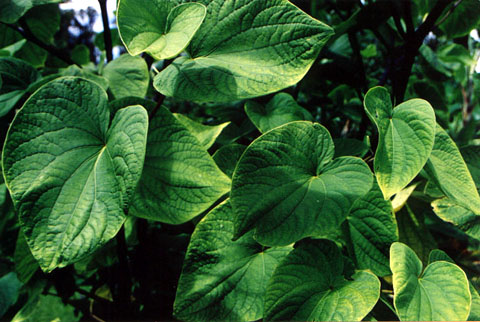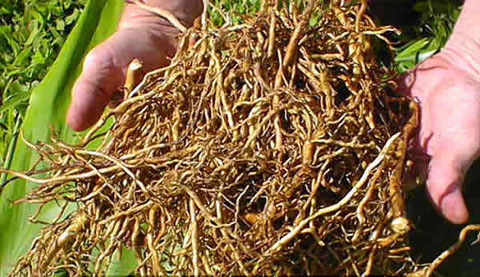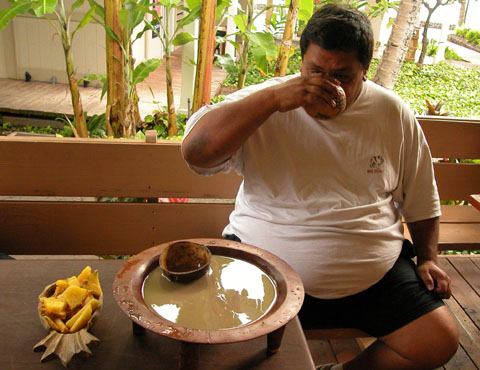Birds and Plants of Kauai:
Awa Plant
by Linda Pascatore on 27 March 2007
The Awa was brought to the Hawaiian islands by the early Polynesians. It was one of their “Canoe Plants”, a group of life-sustaining plants with many uses, which were carried by the Polynesians throughout the Pacific, and has been cultivated for over 3,000 years.
Awa or Piper methysticum, is a member of the pepper family, which is found throughout Polynesia, Melanesia, and Micronesia. It is a shrub which can grow 4 to 12 feet high. It has large, green heart shaped leaves alternate on the stem, growing 8 to 12 inches long, with small flowers spikes, and succulent, thick green or black jointed stems with swollen nodes. In Hawaii, awa is propagated not by seeds, but by dividing the roots. Over 118 different cultivars have been
developed.

image of awa leaves from www.permaculture-hawaii.com/gardens.htm the La'akea Community
Awa is a medicinal plant, which is used by the Hawaiians for many ailments, including sore muscles, colds, headaches, asthma, diabetes, nervousness and urinary problems. It is used as a diuretic and anti-inflammatory, an anticonvulsant, and as a muscle relaxant for spasms and cramping. It is used externally for fungus infection and inflammation.
Awa is also used as a sedative or recreational drug. It is said to promote relaxation, sociability, and mild intoxication. It is non-addictive, and has been used to relieve withdrawal from addictions to alcohol or tobacco. Some have used it as an appetite suppressant to aid in a weight-loss.
Kawa was traditionally prepared by chewing the root to soften it, then putting the chewed root in a calabash or special bowl, mixed with water, and pounded. The resulting liquid is drunk, often from a coconut cup, and followed by a piece of fruit to counteract the bitterness.
In its traditional preparation, no negative effects are reported. However, recently kava actones, thought to be the active ingredient in Kava, has been extracted and put into capsules which are sold as herbal supplements. There have been some reports of health problems resulting from over-use of these extracts.
 image from www.irishnature.com selling noni (promotes well being) and kava promotes sociability) image from www.irishnature.com selling noni (promotes well being) and kava promotes sociability)
The natural form of awa root, in ground powder, is available in health food stores on Kauai, and is more commonly called kava or kava kava powder. This can be prepared by using on tablespoon of kava powder for each cup of water, putting into cheesecloth, and squeezing through the cloth into warm water. Some sort of straining is necessary, as the fiber in kava can cause nausea. Honey can be added. Kava will have a bitter taste, and is traditionally gulped down rather
than sipped. The mouth and tongue will become somewhat numb.
Awa has also traditionally been used for religious or ceremonial purposes by priests or spiritual leaders. It is still used in rituals and ceremonies by many practitioners. It is known to induce relaxation, peace of mind, contentment, and a sharpening of the senses.
There is an ancient reference to awa in a chant to Laka, the goddess of Hula:
“Knowledge from the source, knowledge by hearing,
Like the flourishing ‘awa plant is the knowledge of the gods,
O hear me.”
The use of awa in Hawaii was discouraged by early Christian missionaries because of its association with the traditional Hawaiian religion. Awa use had been largely abandoned by the 1940’s and 50’s. However, during the Hawaiian cultural renaissance in the 1970’s, awa practices were revived, and the popularity of the drug grew. There are a few kava kava bars and cafes currently operating in Hawaii. In contrast, there had been consistent historical
use of awa in other Polynesian islands. Some of their practices have been adopted in Hawaii.
There was a Hawaii Pacific Islands Kava Festival last year at UH Manoa, which was hosted by the Awa Development Council (ADC), a public charitable organization devoted to educational, science, and religious aspects of awa use, at:
http://awadevelopment.org
More info on awa can be obtained from the website
www.canoeplants.com
|




